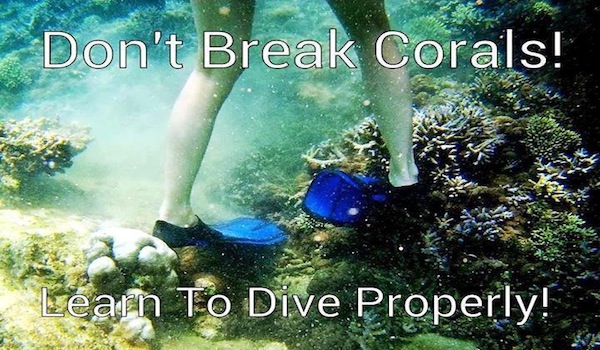What is the Peak Performance Buoyancy Course and Why Should You Take It?
Many years ago, PADI determined that many divers especially new divers had not mastered the skill of neutral buoyancy.

Save corals take the Peak Performance Buoyancy course
The reasons were varied, often it was not enough practice, but sometimes it could be traced back to either inadequate instructions or the student not understanding the principals. If you ask a group of dive professionals and experienced divers what separates an excellent diver from the average one, the answer is buoyancy control.
The Peak Performance Buoyancy Specialty was born out of this type of conditions. While many divers can improve their buoyancy control without an additional course, this specialty will undoubtedly help those that can not, and even those who can will learn and practice techniques that will accelerate the learning process.
Take the Peak Performance Buoyancy Course and become a buoyancy Ninja
Astronauts and scuba divers have a common trait, they are operating in a zero gravity state. That is if the diver has achieved neutral buoyancy. Neutral buoyancy is a condition where you neither sink nor float, and is as close to zero gravity as you can get on earth except for when you are “zero G” aircraft rides and those only last a few minutes.
Astronauts train for Extravehicular Activity (EVA) on a mock-up of the International Space Station that is in a 40-foot deep swimming pool. Their carefully fitted and weighted space suits gives them the perfect neutral buoyancy needed to mimic the conditions in space. It is less complicated but just as important for a diver to achieve neutral buoyancy.
A neutral buoyant diver might not be practicing a skill to make a repair in space, they are practicing a skill that will give them a longer and safer dive. The Peak Performance Buoyancy course will help you expand the knowledge and practice you need to master this skill.
How will you benefit from proper buoyancy control?
The truth is that achieving neutral buoyancy will, indeed, make you a better diver overall. And, in becoming a better and stronger diver, you’ll be able to enjoy your dives more.
Proper weighting is a significant step in achieving neutral buoyancy.
While a diver carries too much weight, they may be able to establish and maintain a neutral state, but they are doing so using a greater amount of air. Additional air to have the BCD counter the extra weight and additional air consumption due to the added resistance of the inflated BCD.
A diver even slightly underweighted will find themselves fighting to maintain a depth for a safety stop and from floating up when they do not want to. Divers who are appropriately weighted will find it easier to maintain neutral buoyancy and will use less air on a dive because they do not have the issues that divers have who take to many or less weights.
Having achieved a level of proper buoyancy control a.ka trim allows a diver to approach a reef without the risk of severely damaging the reef by contact.
If you want to make sure if you are properly weighted you should enter the water in full gear with your BCD fully inflated. Now swim out a bit to just slightly deeper water where you are not able to stand up or touch the bottom. No deflate your BCD and hold your breath. If you are properly weighted, you should now float at eye level. When you exhale, you will descend at a reasonable pace.
If you do not float at eye level when you exhaled and your BCD is empty you might still need a few extra pounds to descent. On the other hand if you sink like a rock before you exhaled you are overweighted and you should adjust the amount of weight accordingly.
Go to the Next Level and Master Peak Performance Buoyancy
Buoyancy control is a skill that can only be learned over time through plenty of practice. If you are a new scuba diver or it’s been a while since your last scuba dive it would be a good idea to enroll in the Peak Performance Buoyancy course.
The Peak Performance Buoyancy course, takes the skills that you already learned in your Open Water Diver course and refines and enhances them so that you can become a better diver.
You’ll learn about proper weight selection, tank positioning, and weight distribution, including trimming your gear so you can be perfectly balanced, as well as how to save air as you move smoothly and hover easily in a horizontal or vertical position.
How is your buoyancy control? Are you a buoyancy Ninja or could you use some practice? Let us know in the comments below.
Would you like to start the Peak Performance Buoyancy Course? Feel free to contact us. We have multiple partners who offer this course.
This article is published by The Scuba Page, the online magazine for Scuba Dive lovers around the world. The Scuba Page is part of RUSHKULT: the online booking platform for adventure sports. Visit the RUSHKULT platform to book your next Scuba Dive training, guided trip and accommodation.

Leave a Comment